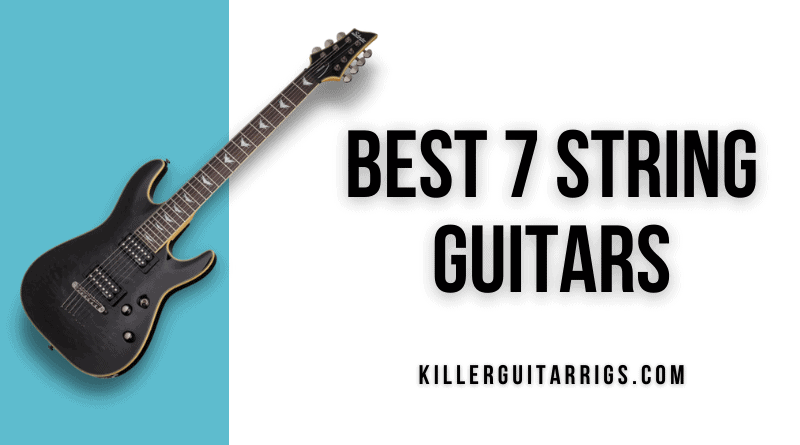Extended range guitars are becoming more popular than ever, and if you want a 7 string that delicately blances features with price, we think you need to take a look at the fantastic Schecter Omen Extreme 7. It offers a perfect blend of form and function, with stunning finish options available, and a brilliantly ergonomic body design. Its thin C neck is fitted with a rosewood fretboard, topped with 24 jumbo frets that make this 7 string surprisingly easy to play. The Schecter Diamond Plus pickups provide a great range of tones, making it useful for a range of genres, although of course, it really does best with metal and other heavy genres. The Schecter Omen Extreme 7 is one of our favorite extended range models, and that’s why we’ve named it as our Top Pick.
When it comes to high performing contemporary guitars, there’s one brand that’s been capturing everyone’s attention, and that’s Strandberg, and in terms of 7 strings, the Strandberg Boden Prog NX-7 really is the benchmark. Featuring a swamp ash body, maple top and neck, and a Richlite multi scale fretboard, this guitar offers next level playability, and thanks to its high end Fishman Fluence active pickups, it offers incredible tones, too. It’s fitted with the best of the best when it comes to hardware, which makes it an ultra reliable choice, which goes a long way to justifying the price tag. It’s available in a range of frankly stunning burl finishes, and being headless, is almost guaranteed to be a conversation starter. In the world of 7 string guitars, it’s impossible to ignore the Strandberg Boden Prog NX-7, and so we’ve named it as our Editor’s Choice.
If you’re looking for something a little more budget friendly, you can’t go wrong with the Ibanez GRG7221. Despite being one of the most affordable 7 strings on the market, it’s still a great option for players of all abilities thanks to its lightweight poplar body, ultra thin maple neck, and its purpleheart fretboard. It’s equipped with high output Infinity R pickups, which serve up a great range of tones, and its hardtail design ensures great tuning stability and intonation. It’s super reliable, even in drop tuning, making it a great choice for metal players. When you consider all that you get for such a low price, it should come as no surprise that the Ibanez GRG7221 picked up our Best Budget prize.
Read more about our review process.
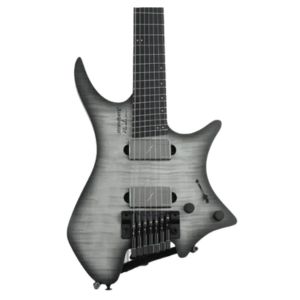
Strandberg Boden Prog NX 7
Features: Fishman Fluence humbuckers, EGS Rev 7 Tremolo bridge, EndurNeck profile
Benefits: Unmatched playability, Super comfortable, Incredibly versatile output
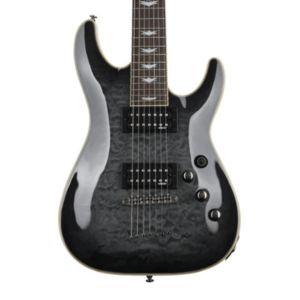
Schecter Omen Extreme-7
Features: Quilted maple top, Push pull coil splitting, String through body
Benefits: Fantastic tuning stability, Huge tonal range, Stunning aesthetics

Ibanez Gio GRG7221M
Features: Hardtail bridge, Infinity R humbuckers, Blacked out hardware
Benefits: Aggressive looks, Great balance and response, Excellent reliability
Contents
Individual Reviews
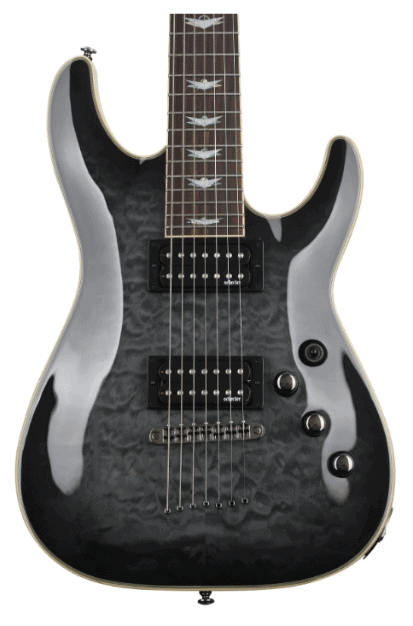
Schecter Omen Extreme-7
A well-built guitar with impressive playability and features.
This is a fantastic all round choice for players looking for a solid starter 7 string. It offers aggressive tones from its dual humbuckers, excellent playability from its slim neck, and even the versatility of push pull coil splitting.
The Omen Extreme-7 is a very familiar-looking and welcoming seven-string guitar. After testing it extensively, we found that it’s perfect for beginners that are just getting started with 7-string guitars.
We were impressed by how smoothly this guitar played right out of the box. The factory setup with the Ernie Ball Slinky strings (0.011-0.056) was good to go after tuning it up.
It has the same solid mahogany body as its 6-string Omen Extreme counterpart, and the one we tested had an all-black finish. On top of the body, there is a layer of transparent gloss polyurethane with slight green undertones that lend it personality.
The bolt-on neck of the Omen Extreme-7 is made of maple and features a thin-C profile with a 16” fretboard radius that we found very comfortable. The 26.5” scale length handled drop tunings very well. The rosewood fretboard looks beautiful with Abalone/Pearloid vector inlays. There are 24 extra-jumbo frets, and we found the Graph Tech XL Black Tusq nut combined with the standard Schecter tuners offered good tuning stability.
A Tune-O-Matic bridge and the string-through-body contribute significantly to the sound of the Omen Extreme-7. There’s a lot of punch to the sound, with deep bass and good sustain.
Both the neck and bridge have Schecter Diamond Plus Humbuckers. The pickups impressed us with their aggressive tone. The controls are versatile, with two volume knobs, one tone knob with push-pull coil-split, and a three-way toggle pickup switch. But we did find that the pickups lacked clarity and articulation when playing hardcore and djent, and we didn’t get the top-end sparkle from our usual clean tones.
Overall, the Omen Extreme is a very well-built guitar with exceptional playability at its price point. It’s the best entry to the world of 7-string guitars. And if you’re serious about it, consider upgrading the pickups for more professional tones.
Verdict: The Schecter Omen Extreme-7 offers the best you can get under $600. The build is solid, looks fantastic, and is packed with features. The playability is excellent, and the pickups offer an aggressive tone. The exceptional specs make it worth buying for beginners and intermediate players alike.
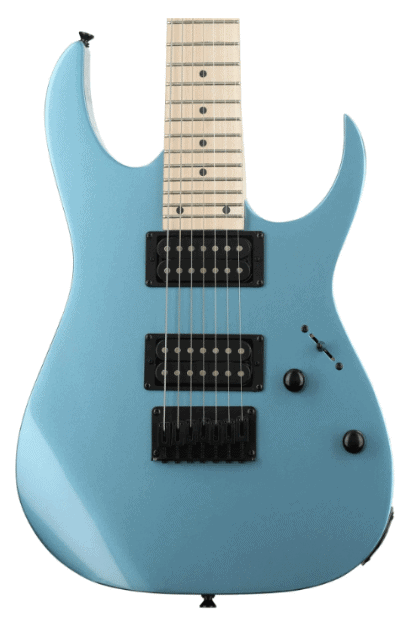
Ibanez Gio GRG7221M
The perfect djent companion on a budget.
With this budget 7 string you get all the basics for diving into the world of 7 string guitars. It offers excellent tonal control, great feel for both rhythm and lead players, and it looks fantastic.
Ibanez surprised us with the quality and playability of the Gio GRG7221M. It is one of the best budget guitars we’ve tried, not just among 7-strings (click here for more).
The Gio GRG7221M has a solid poplar body in the standard super-strat style shape, which we found comfortable and light. We also loved the gloss finish in metallic light blue – it shines on stage and looks pleasing.
The maple neck is bolted on and has a radius of 15.75”, which we found just right for both rhythm and lead. The fingerboard is also maple, which has a light appearance with simple black-dot inlays.
There are 24 jumbo frets that feel standard to Ibanez, but the 25.5” scale length was a bit on the short side for drop tunings. The Ibanez-issued bridge and tuners are both simple and affordable, but they maintain tuning decently despite the plastic nut.
Both the neck and bridge have Infinity R humbuckers, which are Ibanez’s own pickups, and perhaps the only shortcoming on this guitar. For a sub-$300 guitar, we didn’t have high expectations, so we were happy with the mid-focused, biting tones we got from them. But they do lack the clarity, detail, and punch we’ve come to expect from slightly more expensive guitars.
The controls include tone and volume knobs, and a 5-way switch that simulates coil-splitting for better versatility. Testing and playing this guitar was fun: it’s light and easy to adapt to, the shape is well thought out, and while the pickups lack clarity, they’re more than enough to get the job done.
Verdict: The Ibanez Gio GRG7221M is a surprisingly well-designed budget djent machine. It reflects Ibanez’s ability to make affordable guitars with very few compromises. The guitar looks good, plays comfortably, and is versatile, making it a no-brainer at this price point. If you’re on a budget, this’ll get the job done well.
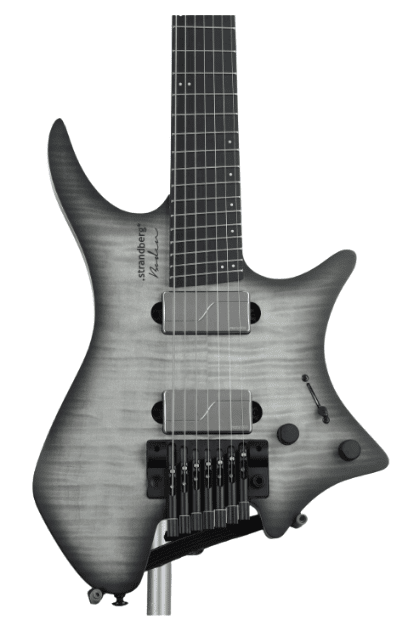
Strandberg Boden Prog NX 7
A space-age guitar with unmatched ergonomics and incredible tone.
This headless 7 string stretches the limits of what's possible with guitar construction. It's one of the most ergonomically sound models on the market, and it delivers punishing tones, with unparalleled tuning stability even when drop tuned.
When we first held the Strandberg Boden Prog NX 7, we could tell that there was something distinctively futuristic about it. This didn’t feel like any of the other guitars we’re used to playing, from the unique headless design to the ultra-light chambered body.
The new NX model is better than the original in just about every way – better ergonomics for better playability and more sustainable materials for the environment-conscious. We found that the body shape is very comfortable, with the curves making it suitable for any playing style. The enhanced arm bevel on the NX felt good, allowing us to play longer without feeling tired.
The multi-scale Richlite fretboard felt smooth and sturdy. The 24 jumbo stainless steel frets running along the 25.5”-26.25” scale length in a fanned pattern were comfortably playable and brought out better nuance while soloing. The EndurNeck profile fit our hands nicely, and the contoured neck joint gave us easy access to all the upper frets.
The highlight of this model is undoubtedly the Fishman Fluence pickups, which is one of our favorites. These pickups always sound fantastic, but they’re well-complemented by the Sassafras body. Clear, detailed articulations even at super-high gain settings and the dual voicings make these pickups perfect for any genre.
We tested this by playing some Meshuggah, and each chug sounded brutal without having to push our amplifier too hard. When we tried playing some clean jazz on ‘Voice 2’, it was equally good – a largely neutral sound, but the high-end was rolled off.
We found the new tremolo bridge is greatly improved, allowing for easier setup and better tuning stability even with dive bombs. And the included multi-tool magnetically attaches to the back of the headstock and is incredibly handy. But what makes the Strandberg special aren’t the headliners – it’s the minute attention to detail.
Verdict: The Strandberg Boden Prog NX 7 is probably the perfect guitar for the modern guitarist. Forward-thinking, sustainable, incredibly ergonomic, and equipped with versatile Fishman pickups, this guitar can play anything you need it to. While it’s expensive, it’s worth it if you’re serious about having a next-gen guitar with excellent playability.
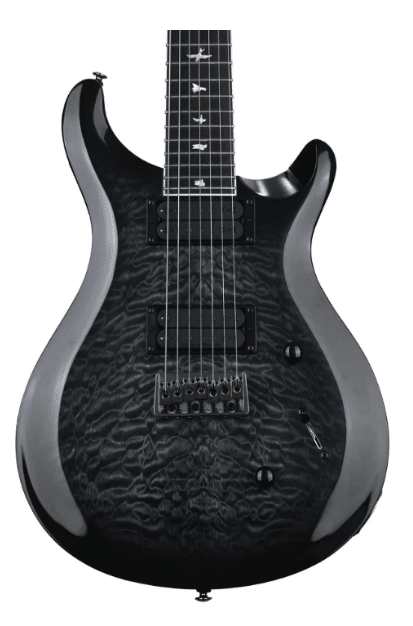
PRS SE Mark Holcomb SVN
The definitive guitar for every djent guitarist, at an affordable price.
Periphery guitarist Mark Holcomb's signature model, and a great choice for players looking to match his tone and style. It's loaded with premium Seymour Duncan pickups, and it's easily one of the best looking 7 string models around.
If you’re looking for a 7-string, you’ve likely listened to Periphery at some point – one of the pioneers of djent. Mark Holcomb’s six-string PRS signature is one of their bestselling guitars and one of our favorites too. So when they released this 7-string model as part of the affordable ‘SE’ lineup, we knew we had to try it.
When we unpacked it from the PRS standard gig bag, the beautiful gloss finish over its quilted maple top immediately stood out. And the Birds inlays on the fretboard looked as good as is expected from PRS.
The Mark Holcomb SVN features a tried-and-tested mahogany body with a maple neck, which felt very sturdy to us. The wide-thin neck profile instantly felt comfortable, while the flat 20” radius ebony fretboard seemed perfect for skilled shredding. The 26.5” scale length and the PRS tuners handled drop tunings very well, even when we tuned down to drop G.
Naturally, the first thing we wanted to play on this guitar was Periphery’s It’s Only Smiles, and it sounded (and felt) faithfully accurate to the original. The Seymour Duncan Alpha and Omega set brings out clarity and nuance like very few passive pickups do, with aggressive mids that cut through the mix and a punchy low-end.
Perhaps our only complaint would be the few compromises to reduce cost – a plastic nut and subpar internal electronics that could easily be replaced with better ones. But these are easy, low-cost fixes that didn’t stop us from enjoying the beauty of this well-made instrument. It’s clear to us why this is Mark’s weapon of choice for his virtuoso playing.
Verdict: The PRS SE Mark Holcomb SVN is a well-designed signature guitar from one of modern metal’s heroes. It comes loaded with Seymour Duncan’s powerful pickups, excellent tonewoods, and top-notch quality control. While it may be intended for Periphery fans, this guitar is versatile enough to please guitarists of all genres.
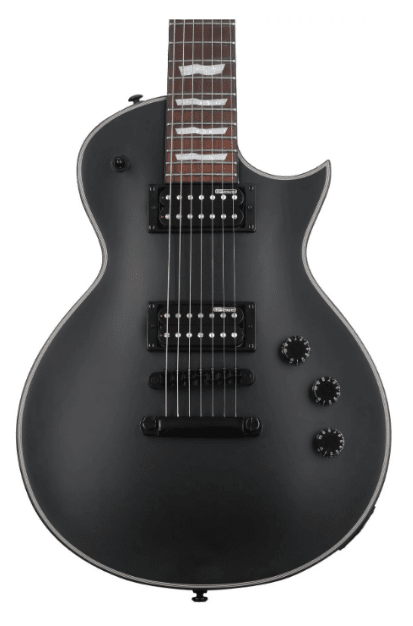
ESP LTD EC-257
An all-satin Les Paul-style axe built for metal.
This fantastic 7 string guitar is one of the best LP style models you'll find today. It has a menacing look with its matte finish, and the ESP pickups make it a real weapon for metal players.
The LTD EC-257 is ESP’s interpretation of a 7-string Les Paul that performs well and is comparatively affordable. If you prefer the iconic rounded shape but need one that’s capable of hardcore metal, this is built for you.
The feel is different from most 7-strings designed for shredding, as this has a rounder neck, and the single-cutaway body is a welcome change from most super-strats.
The all-black satin matte finish offers a smooth texture and a striking appearance to this guitar. The satin covers the entire solid mahogany body with white pinstripe outlines the front of the guitar.
We found the 3-piece mahogany neck is set in with glue, like most Les Pauls. As expected, the EC-257 gave better sustain in our tests due to its construction. The neck shape is thin-U with a radius of 15.74” and we found it to be very comfortable for chords. The fingerboard is roasted Jatoba, with Pearloid flag inlays which suit the design well. The satin felt excellent, especially behind the neck.
There are 22 extra-jumbo frets and the scale length is 25.5”, which we found is a good middle-ground for good down tuning and playability for this body shape. The stock LTD tuners and a Tune-O-Matic bridge with a stop bar tailpiece complete the package, and they were stable enough throughout our tests.
The neck and bridge pickups are ESP LH-150N and ESP LH-150B, respectively. We weren’t amazed by these passive pickups as they lacked nuance, but they get the job done. The controls include a three-way switch, two volume controls, and one tone control with push-pull coil splitting. The clean tones sound decent, but distorted tones were a tad muddy to our ears.
Verdict: The LTD EC-257 is ideal for anyone looking for an affordable djent machine in the classic Les Paul shape. The satin feel and matte look are amazing and blend well with the flag inlays. Its versatility is good with coil-splitting and slightly different neck and bridge pickups. And the set neck offers fantastic sustain. But if you’re looking for a more serious tone, consider upgrading the pickups.
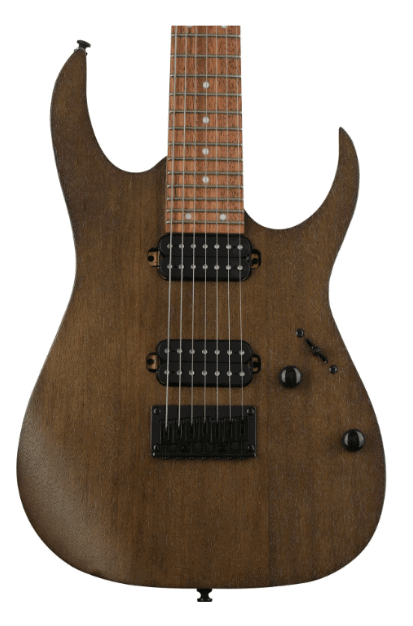
Ibanez RG7421
Combining vintage style and quality with modern metal.
Players looking for an affordable 7 string that delivers better than average build quality and attention to detail will love this Ibanez. It features a simple design, and lets the tones do the talking.
While the Gio series is aimed at budget players, the RG7421 is a step up in specs and quality in just about every way. The better hardware, better electronics, and better playability impressed us, making this ideal for the intermediate player.
We loved the finish of this guitar – the 4-piece mahogany body has a walnut satin polyurethane finish. You can see the wood grain under the finish and even the joints between the individual pieces. The asymmetrical wood construction gives it a great visual character.
The 3-piece maple neck is bolted onto the body with a smooth heel. The neck shape is Ibanez’s Wizard II-7 with a radius of 15.75”, which we found comfortable and ideal for shredding.
The fingerboard is Jatoba with simple pearl dot inlays, features 24 jumbo frets, and a scale length of 25.5”. While the scale wasn’t the best with low tunings, the overall playability was great. The
The stock tuners combined with the fixed bridge with seven individual saddles were reliable and stable during our tests, but the nut is plastic. The neck and bridge pickups are both Quantum Ceramic Humbuckers which we found worked well across different amp settings, and were better than our expectations at this price range.
The controls are one volume and one tone knob, along with a 5-way switch which does a great job of emulating coil-splitting. Based on our tests, any kind of metal would sound good on this guitar, and the cleans sound clear and sparkly too.
Verdict: The Ibanez RG7421 is a great 7-string with a vintage character, but delivers crushing modern-metal tones. It packs great specifications into an affordable package. Ibanez’s Wizard II neck offers incredible playability, and the pickups surpassed our expectations.
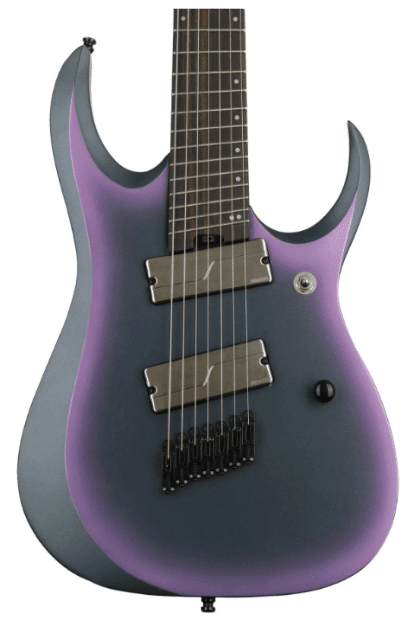
Ibanez Axion Label RGD71ALMS
A wizard’s wand, perfect for fast and technical players.
WIth this incredible shredder, you're getting the ultimate fast playing 7 string guitar. It's fitted with the legendary Wizard neck, and Fishman Fluence pickups, serving up detailed, clear tones at any volume.
It’s clear by now that we love Ibanez, and for good reason. If you’re an advanced guitar player and need a speed demon to take your shredding to the next level, the Ibanez Axion Label RGD71ALMS is excellent.
This model sits on the high-end, but the technology and attention to detail make it ideal for professionals and enthusiasts who love to challenge themselves.
The RGD71ALMS has a solid RGD Axion-shaped body made of Nyatoh, which we found similar to mahogany. The satin matte finish in Black Aurora Burst looks very aesthetic; we noticed how it changes with view angle from purple to grey.
The five-piece neck is compound in construction, with three Panga Panga strips with two walnut strips in between them. The Nitro Wizard-7 bolt-on neck felt like it was made for technical wizardry, and is perfect for technical pieces. The Macassar Ebony fretboard is relatively flat with a 15.75” radius, and has white offset dot inlays. There are glow-in-the-dark side dots made of Luminlay as well.
Aside from the neck, we were also impressed by the 24 jumbo frets, with their multi-scale 25.5”-27” configuration. This made it perfect even for low drop tunings, and offered great playability across the entire fretboard. And the string tension felt just right.
The bridge is a 7-piece Ibanez Mono-rail, and the Gotoh MG-T Locking tuners provide excellent tuning stability. The nut is the only ordinary part made of plastic, which is a bit disappointing at this premium price.
This is another guitar to feature the Fishman Fluence Modern Pickups, which we already loved on the Strandberg. Combined with the Axion Label’s beefy body, the Fluence offered fantastic tones with both clean and distorted settings.
The notes were clear, detailed, and nuanced, and our picking dynamics really shone through. And we found it’s versatile enough to play more than just metal. Controls include a single knob for volume, push/pull voicing for coil splitting, and a 3-way toggle pickup switch.
Verdict: The Ibanez Axion Label RGD71ALMS is a solid choice for any heavy metal guitar player who likes to go fast and technical. This guitar does not cut any corners in build quality or playability, and features one of the best metal pickups we’ve ever reviewed. It looks unique, and is priced well considering the quality you get.
How To Choose The Right 7 String For You
Though all the guitars we have mentioned above are great, making sense of the various specifications and choosing the best 7-string guitar for your own playing style and music can be tough. So here are some critical factors to consider:
Pickups And Electronics
Pickups are an essential part of any electric guitar. The most common application of a seven-string guitar is in heavier genres of music like metal, progressive, and djent. So for these, you need high-output pickups that can handle distortion like a dream while maintaining clarity and nuance.
Of course, pickup quality depends heavily on their price, but even budget 7-string guitars can have pickups good enough for high gain playing. But usually, cheaper pickups struggle with note definition and clean sounds. Good seven-string pickups like the Fishmans sound great even with clean tones, making them perfect for jazz, funk, and blues too.
The best way to test a pickup, as with any guitar, would be to play it yourself in a local shop. But when that’s not possible, consider watching demos of the exact pickup model, and note the amplifiers and pedals used. You can even go by what your favorite artists use, as that’s a great starting point.
Depending on your use case, you may or may not need coil splitting, but it’s often useful to have. Coil splitting is excellent for versatility on stage because it allows you to switch to various pickup configurations and change up your sound in the middle of a song.
Neck And Playability
Another essential aspect of a 7-string guitar is its playability. This is largely influenced by the neck profile, fingerboard, and frets. Since most 7-strings come with jumbo or extra-jumbo frets, you won’t have a problem with them, as they allow for easier fretting.
Next, we have the fingerboard radius. A larger radius means a flatter board. Flatter boards are better for fast shredding, while round boards are more comfortable for chords. This comes down more to preference than anything else; you can sacrifice comfort for speed or vice versa.
The neck profile is sometimes overlooked by beginners but can often define playability. Necks come in various shapes: C, D, U, V, and even asymmetrical or patented shapes like Strandberg’s Endurneck. Consider your existing/previous guitar as a starting point for what shape you’re used to.
The scale length is a major factor on 7-string guitars, which is why many come with multi-scale configurations. 25.5” is a common standard among guitars, but these can suffer during drop tunings. So if you like to play really low tunings like drop G, consider a scale length of 26.5” and 27”.
Multi-scale options like 25.5”-27” are also a great option, but the fanned frets can take some time to adjust for many players.
Body And Hardware
The guitar’s body shape is a major factor in ergonomics. If you’re used to a particular shape for its convenience while sitting and standing, go for it. Like other guitars, 7-strings come in various shapes, but the super-strat is the most common one. If ergonomics is a significant concern, consider Strandberg’s unique headless design.
Hardware is also essential, especially the bridge and tuners. A stable bridge and good quality tuners ensure your guitar maintains tuning for long hours and is reliable enough for gigs.
Lastly, we have looks, which is largely a personal preference. But if you’re spending several hundred dollars on a guitar, you should definitely be happy with how it looks, both during practice and live performances.
If you can make the look of your guitar match your personality, playing style, or the themes that you cover, it can inspire you and become a part of your artistic vision; so do choose a guitar that looks so good you want to pick it up and practice all the time.
Final Thoughts
Seven-string guitars add an extra layer of character and complexity to any guitarist’s performance; they are especially relevant in heavy metal, but used even in jazz and folk music. Getting a 7-string two decades ago was quite expensive, but they’re more affordable than ever now, with incredible manufacturing and quality control.
In summary, the Schecter Omen Extreme-7 won our best value award for incredibly balanced specs, and the Ibanez Gio GRG7221M is our best budget pick, perfect for beginners. But if you’re looking to spend for the best of the best, our editor’s choice is the Strandberg Boden Prog NX 7 – a marvel in guitar engineering.

